Irish orphans sent to Australia remembered in Tyrone
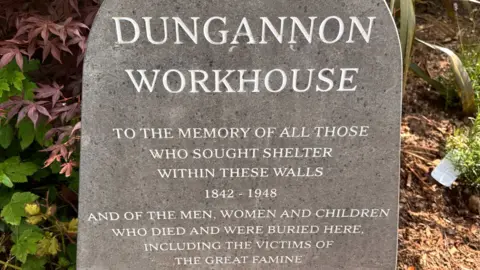 BBC
BBCOn a quiet hill, overlooking the town of Dungannon, sits a memorial stone.
An inscription reads: "To the memory of all those who sought shelter within these walls".
Four pebbles were recently placed on top of it and the names of 21 young girls were read out loud.
It was part of a remembrance service on the grounds of South Tyrone Hospital, the former site of Dungannon Workhouse.
Each pebble represented 1,000 people who passed through its doors between 1842 and 1948.
The names belong to a group of young women from County Tyrone who were sent from the workhouse to Australia between 1848 and 1850.
They were part of a group that would become known as the Irish Famine Orphan Girls.
A place of last resort
In 1845, as poverty and starvation increased during the famine in Ireland, workhouses began to open.
Their purpose was to offer succour and survival, but there was a saying that "the road to the workhouse was the road to death" - and for thousands it was.
For more than 100 years Dungannon workhouse was a place of last resort for thousands of men, women, and children who faced famine, poverty and illness.
Those who died in Dungannon workhouse are buried in a large-scale paupers' grave on the site close to what is now South Tyrone Hospital.
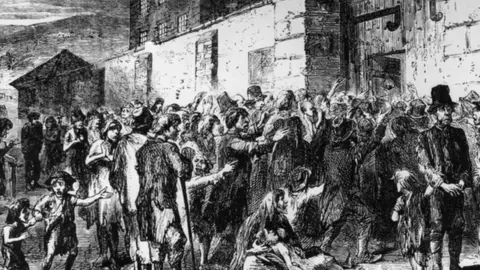 Getty Images
Getty ImagesOn the hospital grounds there is a memorial garden in tribute to those who lived and died in the workhouse.
The Southern Trust, which owns the land, recently refurbished the garden in preparation for a memorial event at the end of June to honour the history of the site.
Members of Donaghmore Historical Society helped organise the event.
Mary MacGinty is chair of the society.
She said: "It is about honouring the lives of those who passed through the doors of Dungannon Workhouse and it's important to remember this is still very recent history, the workhouse only closed in 1948."
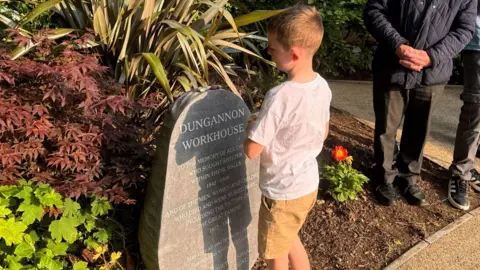
'I remember the workhouse children'
Frank Shields is a member of the historical society who has memories of seeing children from Dungannon Workhouse at his school.
Born in 1939 he said he remembers the young girls from the workhouse "vividly".
"They wore these laced up black boots, like soldiers' boots, a grey skirts and dark coloured cardigans - they were dressed differently than everyone else.
"I also remember the young boys from the workhouse, they all wore these cut down grey trousers and often they had this brown paper bag with just a piece of bread in it, God help them."
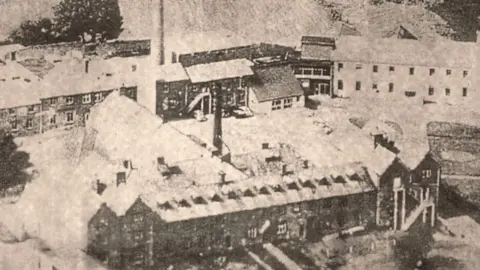 Donaghmore Historical Society
Donaghmore Historical SocietyThe Donaghmore Historical Society has also been working closely with another historical group in Australia.
Together they have traced a number of girls who were sent from Dungannon Workhouse to Melbourne.
They were sent as part of the Earl Grey Scheme.
Under the scheme between 1848 and 1850, more than 4,000 young Irish female orphans left workhouses and were transported to Australia.
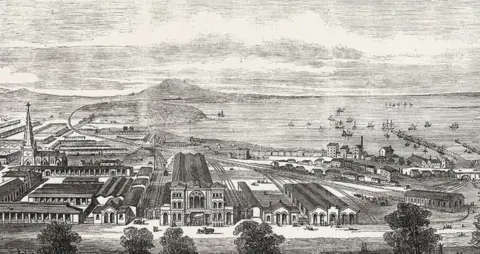 Getty Images
Getty ImagesThe Earl Grey Scheme
Earl Grey was secretary of state for the colonies and the aim of the scheme was to reduce overcrowding in workhouses and provide labour for Australia while reducing a big gender imbalance there.
Of the 4,114 Irish Famine orphan girls sent to Australia, 94 were from County Tyrone and 21 of those girls came from Dungannon Workhouse.
Siobhan O'Neill lives in Melbourne and is part of the Famine Orphan Girls Commemoration Committee.
"The girls from Dungannon left in January during an Irish winter, spent three months on a boat and they would have arrived during an Australian summer, so it must have felt so alien to them," she said.
"It was a new colony so it would have been quite the frontier, many were treated with shame, but they were also very resilient and ended up raising large families and prospering."
A tribute was paid to the girls during the recent memorial service on the site of the former Dungannon Workhouse.
While a traditional Irish ballad was played, the names of the young women were read out loud.
This included the name of Eliza Addy.
'I'm humbly proud'
Eliza Addy was born in 1834 in Dungannon and had worked as a domestic servant before entering the workhouse. When she was 16 years old she was chosen for the Earl Grey Scheme.
She arrived in Melbourne on 10 January 1850 and would go onto work on a farm in Melbourne.
In 1854 she married and had nine children. She died in the western Victorian town of Stawell in 1910.
Descendants of Eliza Addy regularly attend the annual Irish Famine Orphan Girls Commemoration in Australia.
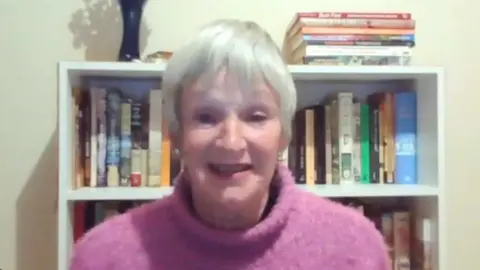
Her great, great, great granddaughter Leanne Seignior still lives in Australia.
She says her family have been very touched by Eliza's inclusion in the Dungannon workhouse ceremony.
She added: "It blows my mind to think about how much she went through and survived, from the famine, to the trauma of the workhouse, then the boat trip and to arrive across the world at that age.
"To find the strength and resilience to keep goingm raise her family and now all these generations later to be remembered in her home country makes me incredibly humbly proud."
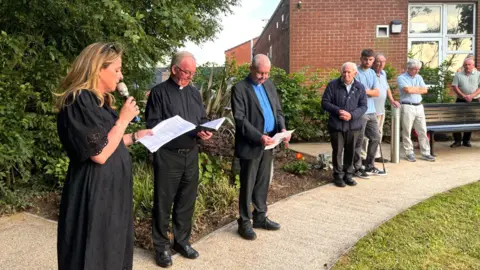
There has also been ongoing work to uncover more information about other workhouses in mid ulster.
The old building of Magherafelt Workhouse still exists in the form of Mid Ulster Hospital.
Seamus O'Brien from the Loup Historical Society was at the memorial event for Dungannon Workhouse.

Seamus is asking people to come forward with any information on the workhouse, including relics such as records books.
"We're particularly interested in trying to find the old bell - it's about documenting this for future generations."
A new memorial stone and information board at the main entrance to the former site of Magherafelt Workhouse is due to be unveiled at a launch event on 31 July.
